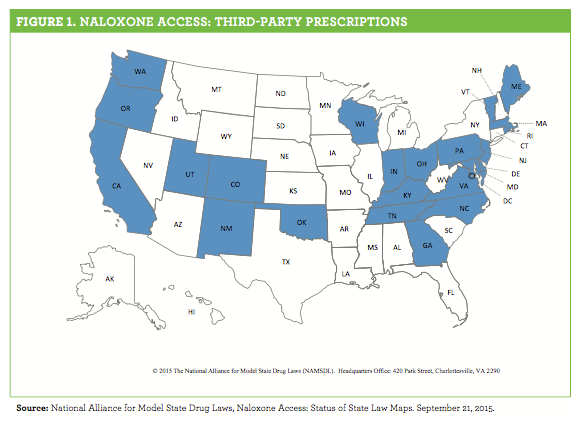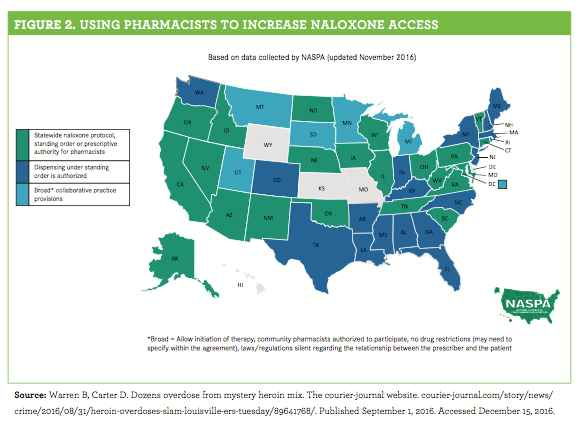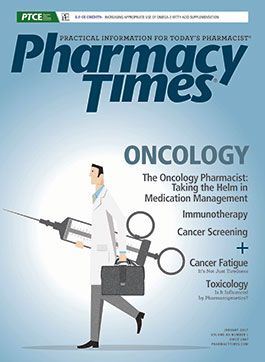Publication
Article
Pharmacy Times
Increasing National Naloxone Access: Kentucky Is First to Open Online Naloxone Registry
With mortality rates continuously climbing due to drug overdoses, the Kentucky Office of Drug Control Policy now provides an active online registry that allows patients to locate pharmacies that supply naloxone without a patient-specific prescription.
With mortality rates continuously climbing due to drug overdoses, the Kentucky Office of Drug Control Policy (ODCP) now provides an active online registry (odcp.ky.gov/ Stop-Overdoses/Pages/Locations.aspx) that allows patients to locate pharmacies that supply naloxone without a patient-specific prescription. Patients can view a pin-drop map of locations that dispense naloxone; they can search by city, county, or zip code. The ODCP plans to continue updating this site, as more pharmacies are beginning to stock the medication for at-risk patients across the state.
The website, which also provides information about naloxone and an overdose response guide, is maintained by the ODCP in partnership with the Kentucky Board of Pharmacy, the Kentucky Agency for Substance Abuse Policy, and Advancing Pharmacy Practice in Kentucky Coalition (APPKC). APPKC, a unit of the University of Kentucky College of Pharmacy, continues to work to locate pharmacies to add to the registry that (1) employ pharmacists who are naloxone-certified and (2) have an approved protocol in place with a physician for dispensing. There is also a tab for contacting the ODCP, where patients or concerned family members and friends can provide contact information and comments, and a treatment center locator.
This online registry represents an additional step in implementing Kentucky’s relatively new naloxone legislation, which was enacted in 2015 as Kentucky Senate Bill 192. Sometimes known as “The Heroin Bill,” it allows pharmacists to dispense naloxone pursuant to a specific protocol that can be accessed online at the Kentucky Board of Pharmacy website (pharmacy.ky.gov/Pages/default.aspx),1 and provides pharmacists with such information as (1) who is eligible to receive naloxone prescriptions and (2) guidelines they must meet for patient education, including explaining risk factors for opioid overdose, strategies for prevention, and administration procedures. Because of this new legislation, prior to dispensing naloxone, pharmacists must attend a 1.5-hour training session that addresses aspects of the new legislation, including the criteria necessary to meet the requirements of the protocol and the documentation they must complete after dispensing the medication.2
Kentucky Senate Bill 192, which amended KRS 217.186, is an important step toward pharmacists’ gaining provider status. The bill states, “A licensed health care provider who, acting in good faith, directly or by standing order, prescribes or dispenses the drug naloxone, to a person or agency.”3 Further, the definition of a “licensed health care provider,” as detailed in KRS 315.010, now includes a pharmacist holding a certification issued by the Board of Pharmacy as being able to authorize the initiation of naloxone dispensing.4
The Kentucky ODCP website also includes explanations of related laws, including the following:
- Casey’s Law of 2004, which allows close family or friends to intervene and petition the court for treatment of the patient.5
- The Good Samaritan Law, which protects from prosecution those who report a drug overdose.
Additionally, the website includes testimonials from drug addicts and their close relatives, giving the public better insight into the firsthand experiences and challenges associated with drug addiction.
Other innovative ways to give patients access to naloxone have been implemented across the United States, such as the approach used at Massachusetts General Hospital, which dispenses the medication to at-risk patients’ bedsides before discharge, and the University at Buffalo, which offers free online training to pharmacists wishing to dispense naloxone. (Kentucky requires in-person training.6)

One important aspect of the statutory revision is authorization to dispense naloxone to a “person or agency,” not just a patient.7 If a prescription is dispensed for use in another individual with an opioid addiction, issues will likely arise regarding coverage of the prescription cost by insurance because the individual receiving the medication may not be using it, although that person is being counseled on the medication. Currently, the naloxone 0.4-mg/0.4-mL auto-injector is the preferred dis- pensing method, according to the American Pharmacists Association. It is costly—at $345 per unit—but is only covered by some third-party plans, depending on patient risk.8 Medicaid reimburses certain providers for offering counseling on prescription medications and naloxone is covered by most insurance plans when dispensed in a health care setting, but pharmacists who dispense naloxone are not covered. Few plans cover the medication when it is dispensed by a pharmacist for take-home use.
The naloxone protocol requires pharmacists to counsel patients on its use, the risk factors, and drug overdose prevention. However, these counseling services are not reimbursed even though pharmacists are considered providers pursuant to their state protocol, dispensing it without a prescription from a physician. Advocating for further third-party understanding of the pharmacist’s role in dispensing naloxone and the essential counseling that pharmacists provide to patients could help to expand reimbursement to pharmacists’ counseling services. Billing for clinical pharmacy services has always been an obstacle faced by the pharmacy profession. Achieving provider status for naloxone dispensing is a key driver in promoting the expansion of pharmacist reimbursement.9 In 4 states—Washington, California, North Carolina, and New York—Medicaid reimburses for take-home naloxone from the pharmacy.

The Kentucky Pharmacists Association and coalition partners have worked to expand its educational program, training 484 pharmacists and 199 student pharmacists on naloxone use since summer 2015.10 According to data provided to the Courier-Journal, Metro Emergency Management Services in metro Louisville, Kentucky, administered around 1000 doses of naloxone from January through July of 2016 compared with 425 doses in the same time frame of 2015.11 As the nationwide epidemic continues, it is important to educate the general public, a key goal of Kentucky’s new registry website. Giving pharmacists more autonomy through prescriber authority, collaborative care agreements, and protocols (eg, for naloxone) (figures 1 and 2) could reduce the increasing number of deaths due to drug overdoses, which has grown 200% since 2000.12
Sophia Brown, a native of Louisville, Kentucky, is a second-year PharmD student at the University of Kentucky College of Pharmacy. Joseph L. Fink III, BSPharm, JD, is professor of pharmacy law and policy and the Kentucky Pharmacists Association Professor of Leadership at the University of Kentucky College of Pharmacy, Lexington.
References:
- Sample naloxone protocol: protocol to initiate dispensing of naloxone for opioid overdose prevention and response. Kentucky Board of Pharmacy website. .ky.gov/Documents/Sample Naloxone Protocol and Education Sheets.pdf. Accessed December 15, 2016.
- 201 K.A.R. 2:360(4).
- KY S.B. 192 [2015 — Reg. Session] (2015, March 25).
- K.R.S.315.010.
- Information about Casey’s Law. Transitions website. transitionsky.org/information-about-caseys-law/. Accessed December 15, 2016.
- Pharmacists key to expanding naloxone distribution. American Pharmacists’ Association website. pharmacist.com/pharmacists-key-expanding-naloxone-distribution. Published June 24, 2016. Accessed December 15, 2016.
- Revision of K.R.S. 217.186, Kentucky SB 192
- Advancing Pharmacy Practice in Kentucky Coalition. Increasing naloxone access in Kentucky: implementation of SB 192 by pharmacists. Presented at: 137th Kentucky Pharmacists Association Annual Meeting; June 28, 2015; Bowling Green, KY. c.ymcdn.com/sites/www.kphanet.org/resource/resmgr/2015_AM_Presentations/Naloxone_training_program_6-.pdf. Accessed December 15, 2016.
- Seiler, N, Horton K, Malcarney MB. Medicaid reimbursement for take-home naloxone: a toolkit for advocates. PrescribeToPrevent website. prescribetoprevent.org/wp2015/wp-content/uploads/naloxone_medicaid_report_gwu.pdf. Accessed December 15, 2016.
- Bonner L. Naloxone access: more states look to pharmacists to increase naloxone access. Pharmacy Today website. pharmacytoday.org/article/S1042-0991(16)00241-3/fulltext. Published February 2016. Accessed December 15, 2016.
- Warren B, Carter D. Dozens overdose from mystery heroin mix. The courier-journal website. courier-journal.com/story/news/crime/2016/08/31/heroin-overdoses-slam-louisville-ers-tuesday/89641768/. Published September 1, 2016. Accessed December 15, 2016.
- Sarasohn-Kahn J. Naloxone in retail health—helping the opioid epidemic at pharmacies and grocery stores. Ocular Prime website. blog.healthpopuli.com/category/medicines/#/2016/08/18/naloxone-retail-health-helping-opioid-epidemic-pharmacies-grocery-stores/. Published August 18, 2016. Accessed December 15, 2016.







